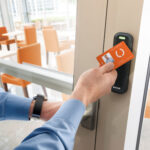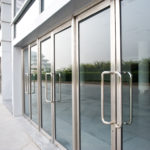I’m continuing to revise my Decoded articles to maintain them as an up-to-date resource for the industry…familiarity with use groups and occupancy classifications is crucial to understanding and applying the codes.
This post was published in Doors & Hardware

When working through a code question, the first thing to determine is which code to reference. If the project is in the design or construction phase, the applicable code would typically be the building code that was in effect when the building permit was granted. In most states, the adopted building code is the International Building Code (IBC), often with state modifications. It’s important to note which edition of the IBC has been adopted in a project’s jurisdiction, as the model codes are updated on a 3-year cycle and the requirements differ from one edition to the next.
If the question is regarding an existing building, the prevailing code would typically be the adopted fire code for the project’s location – possibly NFPA 1 (which references NFPA 101 – The Life Safety Code) or the International Fire Code (IFC). Sometimes the question is more specific and requires the use of a referenced standard, but the adopted building code or fire code will determine which edition of the standard has been adopted. Referencing the wrong edition of a code or standard can result in incorrect information, and it’s crucial to check for state or local modifications to the model codes.
The next thing to consider is the use group or occupancy classification for the building or space where the door opening in question is located. In Chapter 3, the IBC defines each “use group” and NFPA 101 – Chapter 6 describes each “classification of occupancy.” Both terms describe how the building or a portion of the building will be used, and each of these codes contain requirements specific to certain uses. For example, the egress and fire protection requirements of an educational occupancy that would typically be occupied by a large number of children would be different from the requirements for a health care occupancy where occupants may be incapable of self-preservation.
| The IBC includes the following use groups, many of which are divided into sub-groups. In some cases, the subgroups are classified in order from highest hazard to lowest, although this is not the case for every occupancy type. | NFPA 101 defines the following classifications of occupancy, and includes detailed requirements for each occupancy type in Chapters 12-42. Examples of each occupancy classification can be found in Annex A of NFPA 101. |
| · Assembly: Groups A-1, A-2, A-3, A-4, A-5 | · Assembly |
| · Business: Group B | · Educational |
| · Educational: Group E | · Day-Care |
| · Factory and Industrial: Groups F-1, F-2 | · Health Care |
| · High Hazard: Groups H-1, H-2, H3, H-4, H-5 | · Ambulatory Health Care |
| . Institutional: Groups I-1, I-2, I-3, I-4 | . Detention and Correctional |
| · Mercantile: Group M | · Residential |
| · Residential: Groups R-1, R-2, R-3, R-4 | · Residential Board and Care |
| · Storage: Groups S-1, S-2 | · Mercantile |
| · Utility and Miscellaneous: Group U | · Business |
| · Industrial | |
| · Storage |
When two or more occupancies are present in the same building, the code requirements for each type must be addressed depending on the building’s floor plan. NFPA 101 defines two types of multiple occupancies. A mixed occupancy is where occupancies are intermingled, and the most restrictive fire and life safety requirements apply to the whole building. A separated occupancy is where two or more occupancies exist and the occupancies are separated by fire resistance rated assemblies – in this case, each part of the building is treated as the applicable occupancy classification.
NFPA 101 also classifies the level of hazard presented by the contents of a building as either low hazard (unlikely to sustain fire), ordinary hazard (expected to burn with some rapidity or to create a substantial amount of smoke), or high hazard (burn rapidly or explode). The vast majority of buildings are considered to have ordinary hazard contents.
It’s important to understand which occupancy classification applies to your project, because the requirements often vary by occupancy. For example:
- Panic hardware is required for egress doors that are equipped with a lock or latch when serving a certain calculated occupant load (50+ occupants for recent editions of the IBC, 100+ occupants for NFPA 101). However, this requirement only applies to assembly and educational occupancies (and day-care per NFPA 101). Panic hardware is also required for high hazard occupancies. However, egress doors serving other use groups are not required by the model codes to have panic hardware even if they have a high occupant load. For example, panic hardware would not typically be required by these codes for a retail store, because that would be a mercantile occupancy.
- Delayed egress locks were not allowed by the IBC prior to the 2018 edition for doors serving assembly, educational, or high hazard use groups. Beginning with the 2018 edition two exceptions were added: 1) delayed egress locks are now, permitted on classroom doors in educational occupancies if the calculated occupant load of the room is less than 50 people, and 2) delayed egress locks are permitted on secondary egress doors in courtrooms, if the building is fully sprinklered. NFPA 101 has varying limitations on the use of delayed egress locks depending on the occupancy classification. In assembly occupancies, for example, delayed egress locks may be used on doors other than the main entrance door (consult the pertinent occupancy chapter in NFPA 101 for other limitations).
- Residential dwelling units are typically allowed to have a latchset and a separate security device (deadbolt, door guard, security chain) which would require two motions to unlatch, as long as no key, tool, special knowledge or effort is required. For means of egress doors in almost all other occupancies, one operation must unlatch the door.
It can sometimes be difficult to determine the correct occupancy classification, so the applicable code must be consulted. The same building may be considered different occupancy types by the I-Codes and the NFPA codes, or a space may change function based on the occupant load. For example:
- According to NFPA 101, a college classroom building is a business occupancy, but if a college classroom holds 50 occupants or more, it is an assembly occupancy.
- Ambulatory health care facilities must comply with the requirements for ambulatory health care occupancies in addition to the requirements for business occupancies.
- Child day care centers are considered day-care occupancies per NFPA 101, but may be Group I (institutional) or Group E (educational) per the IBC and IFC.
- A training room within an office building is not considered an assembly use group by the I-Codes unless it has a calculated occupant load of 50 people or more, or is over 750 square feet in area.
- NFPA 101’s health care, board and care, detention and correctional occupancies are all considered I (institutional) use groups per the IBC and IFC.
After determining the adopted code, be sure to identify the occupancy classification(s) or use group(s) for the project in question before attempting to apply the code requirements. This information is usually available from the architect, since there are many aspects of a building’s design and construction that are based on the occupancy type. Consult state and local codes for information pertinent to your project’s jurisdiction as requirements may vary, and as always, the Authority Having Jurisdiction (AHJ) has the final say in matters of code-compliance.
You need to login or register to bookmark/favorite this content.










[…] the building is in California), paddle latches meet egress and accessibility requirements for most Group B occupancies. Examples of this occupancy include office buildings, banks, professional services and educational […]